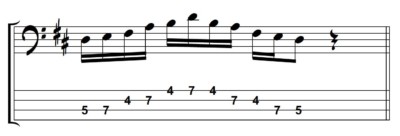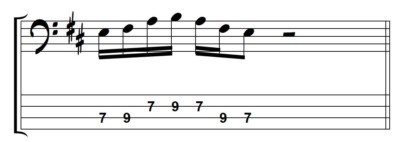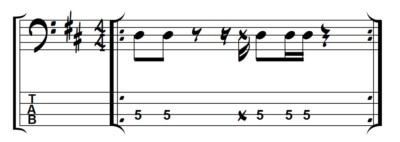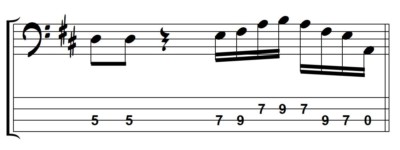This week we’re going to take a look at Pentatonic Scales and a simple approach for playing up and down the fretboard rather than across the fretboard.
The Major Pentatonic Scale
As a refresher, to build a major pentatonic scale just take a major scale and remove the 4th and 7th.
- C Major Scale: C D E F G A B
- C Major Pentatonic: C D E G A

Two String Sets
One of the biggest problems we face as bass players is addressing scales up and down the neck instead of across the fretboard. The key is to switch your focus from three strings, to two strings.
For these examples we’ll use the D Major Pentatonic scale to provide a little more real estate up and down the fretboard:

If we break the Major Pentatonic down into smaller subsets occupying only 2 strings at any one time we find the following cells:
Cell #1:

Cell #2:

Cell #3:

Cell #4:

Cell #5:

These cells can be repeated both above and below those specified. They can also be played on other 2 string combinations such as the E/A string and D/G string.
Practice Tip:
We can incorporate these cells into our practice by playing them as fills around a basic riff:
Practice Track 88bpm:
Practice Track 98bpm:

Fills can be played as shown in the video. Below is an example of a fill in the second half of the bar:














The notes on the website here suddenly make it all look so much clearer. Really useful lesson.
great lesson as usual, Mark!!!
Thanks Mark ,another step closer to understanding the fretboard
Always very clear instructions. Now to practice!
Agreed,
Much more useful than trying to learn all 5 formats and linking them. I very much like the two string approach which can then be augmented later with the full 4 string formats after these two string forms are, as Mark would say, ‘under our fingers’. Now, to that bass…..
That was one of my favourite lessons. Very useful.
Great material Mark!
No longer marooned on desert island due to renewed courage to venture out into uncharted
areas.lol Great pentatonic practice method.
Who else went right back to the island in Myst?
Great lesson Mark!
I’ve been working on running patterns all over the fretboard but was burning out on running arpeggios in all three finger positions. This is a great concept that can be applied to any scale or note sequence.
Thanks,
Mark
CT-USA
I love how you included the lesson plan with each video. Excellent!
Thank you for the lesson Mark
Is it possible to shuffle the note sequence ??
Another great lesson,I am working my way through the creating bass lines and fills section.
Question. I notice that the fingering pattern differs in some cells (for example cell #1 and cell #2). What’s going on here? It doesn’t seem to follow the typical major pentatonic fingering pattern and changes depending on the root note. Can someone provide an explanation? Thanks.
I love the lessons. Each one extremely well done and informative. I wish I had this resource in my formative years.